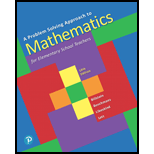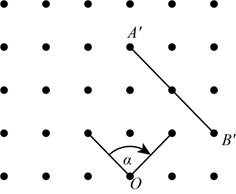
A Problem Solving Approach To Mathematics For Elementary School Teachers (13th Edition)
13th Edition
ISBN: 9780135183885
Author: Rick Billstein, Shlomo Libeskind, Johnny Lott, Barbara Boschmans
Publisher: PEARSON
expand_more
expand_more
format_list_bulleted
Question
Chapter 14.1A, Problem 11A
To determine
The

Expert Solution & Answer
Want to see the full answer?
Check out a sample textbook solution
Students have asked these similar questions
Explain the key points and reasons for the establishment of 12.3.2(integral Test)
Use 12.4.2 to determine whether the infinite series on the right side of equation 12.6.5, 12.6.6 and 12.6.7 converges for every real number x.
use Cauchy Mean-Value Theorem to derive Corollary 12.6.2, and then derive 12.6.3
Chapter 14 Solutions
A Problem Solving Approach To Mathematics For Elementary School Teachers (13th Edition)
Ch. 14.1 - Prob. 1MCCh. 14.1 - Prob. 3MCCh. 14.1 - Prob. 5MCCh. 14.1 - Prob. 6MCCh. 14.1 - Prob. 7MCCh. 14.1 - A drawing of a cube, shown in the following...Ch. 14.1 - Wall stenciling has been used to obtain an effect...Ch. 14.1 - Prob. 10MCCh. 14.1 - The following figure is a partial tessellation of...Ch. 14.1 - Prob. 12MC
Ch. 14.1 - Prob. 13MCCh. 14.1 - Prob. 14MCCh. 14.1 - Prob. 15MCCh. 14.1 - Prob. 18MCCh. 14.1 - Prob. 19MCCh. 14.1 - Prob. 20MCCh. 14.1 - Prob. 21MCCh. 14.1 - Karrin claims that centers of rotation must be at...Ch. 14.1 - A student asks if the image seen through a...Ch. 14.1 - Jillian wants to know why a regular pentagon will...Ch. 14.1 - Prob. 26MCCh. 14.1 - Prob. 1NAEPCh. 14.1 - Prob. 2NAEPCh. 14.1 - Prob. 3NAEPCh. 14.1A - For each of the following, find the image of the...Ch. 14.1A - Prob. 2ACh. 14.1A - Find the coordinates of the image for each of the...Ch. 14.1A - Prob. 4ACh. 14.1A - Prob. 7ACh. 14.1A - Prob. 8ACh. 14.1A - Prob. 9ACh. 14.1A - Prob. 11ACh. 14.1A - Prob. 12ACh. 14.1A - Prob. 13ACh. 14.1A - Prob. 14ACh. 14.1A - Prob. 15ACh. 14.1A - A 1-inch blue square piece of sidewalk chalk is...Ch. 14.1A - Prob. 17ACh. 14.1A - Prob. 18ACh. 14.1A - Prob. 19ACh. 14.1A - Prob. 20ACh. 14.1A - Prob. 22ACh. 14.1A - Prob. 23ACh. 14.1A - Prob. 24ACh. 14.1A - Prob. 25ACh. 14.1A - Prob. 26ACh. 14.1A - Prob. 27ACh. 14.1A - Prob. 28ACh. 14.1B - Prob. 2ACh. 14.1B - Prob. 3ACh. 14.1B - Prob. 4ACh. 14.1B - Prob. 7ACh. 14.1B - Prob. 11ACh. 14.1B - Prob. 12ACh. 14.1B - Prob. 13ACh. 14.1B - Prob. 14ACh. 14.1B - Prob. 15ACh. 14.2 - Prob. 1MCCh. 14.2 - Prob. 2MCCh. 14.2 - Prob. 3MCCh. 14.2 - Prob. 4MCCh. 14.2 - Prob. 5MCCh. 14.2 - Prob. 6MCCh. 14.2 - Prob. 7MCCh. 14.2 - Prob. 8MCCh. 14.2 - Prob. 9MCCh. 14.2 - Prob. 13MCCh. 14.2 - Prob. 15MCCh. 14.2 - Prob. 17MCCh. 14.2 - Prob. 18MCCh. 14.2 - Prob. 19MCCh. 14.2 - Prob. 20MCCh. 14.2 - Prob. 22MCCh. 14.2 - Prob. 1NAEPCh. 14.2 - Prob. 2NAEPCh. 14.2 - Prob. 3NAEPCh. 14.2 - Prob. 4NAEPCh. 14.2 - Prob. 5NAEPCh. 14.2A - Assessment 14-2A Describe how to find the image of...Ch. 14.2A - Prob. 2ACh. 14.2A - Assessment 14-2A Determine the final result when...Ch. 14.2A - Prob. 4ACh. 14.2A - Assessment 14-2A a. Refer to the following figure...Ch. 14.2A - Prob. 6ACh. 14.2A - a. Reflect triangle ABC across line j, then across...Ch. 14.2A - Assessment 14-2A Given ABC and its reflection...Ch. 14.2A - Prob. 9ACh. 14.2A - Prob. 10ACh. 14.2A - Decide whether a reflection, a translation, a...Ch. 14.2A - a. Conjecture what the image of a point with...Ch. 14.2A - Prob. 16ACh. 14.2A - Prob. 17ACh. 14.2A - Prob. 18ACh. 14.2A - Point P is the image of P not shown under a glide...Ch. 14.2A - Consider the glide reflection determined by the...Ch. 14.2B - Prob. 1ACh. 14.2B - Prob. 2ACh. 14.2B - Determine the final result when ABCis reflection...Ch. 14.2B - Prob. 4ACh. 14.2B - Prob. 6ACh. 14.2B - Prob. 7ACh. 14.2B - Prob. 8ACh. 14.2B - Prob. 9ACh. 14.2B - Prob. 10ACh. 14.2B - Prob. 11ACh. 14.2B - Prob. 12ACh. 14.2B - Prob. 13ACh. 14.2B - Prob. 14ACh. 14.2B - Prob. 15ACh. 14.2B - In which line will the two intersecting circles...Ch. 14.2B - Prob. 18ACh. 14.2B - If PQ is the image PQ not shown under a glide...Ch. 14.2B - Prob. 20ACh. 14.2B - Prob. 21ACh. 14.3 - Prob. 1MCCh. 14.3 - Prob. 2MCCh. 14.3 - Prob. 3MCCh. 14.3 - Prob. 5MCCh. 14.3 - Prob. 6MCCh. 14.3 - Prob. 7MCCh. 14.3 - Prob. 8MCCh. 14.3 - Prob. 9MCCh. 14.3 - Prob. 10MCCh. 14.3 - Prob. 12MCCh. 14.3 - Prob. 13MCCh. 14.3 - Prob. 14MCCh. 14.3 - Prob. 15MCCh. 14.3 - Prob. 16MCCh. 14.3 - Prob. 17MCCh. 14.3A - In the following figures, describe a sequence of...Ch. 14.3A - Prob. 2ACh. 14.3A - In each of the following drawings, find...Ch. 14.3A - Prob. 4ACh. 14.3A - AB is the image of a candle AB produced by a box...Ch. 14.3A - Prob. 6ACh. 14.3A - Prob. 7ACh. 14.3A - Prob. 8ACh. 14.3A - Prob. 9ACh. 14.3A - Prob. 10ACh. 14.3A - Prob. 11ACh. 14.3A - Prob. 12ACh. 14.3A - Prob. 13ACh. 14.3B - Prob. 1ACh. 14.3B - Prob. 2ACh. 14.3B - Prob. 4ACh. 14.3B - Prob. 5ACh. 14.3B - Prob. 6ACh. 14.3B - Prob. 7ACh. 14.3B - Prob. 8ACh. 14.3B - Prob. 9ACh. 14.3B - Prob. 11ACh. 14.3B - Prob. 12ACh. 14.3B - Prob. 13ACh. 14.CR - Prob. 1CRCh. 14.CR - Prob. 2CRCh. 14.CR - Prob. 3CRCh. 14.CR - Prob. 4CRCh. 14.CR - Given that STAR in the figure shown is a...Ch. 14.CR - Prob. 6CRCh. 14.CR - Given that SNOSWO in the following figure,...Ch. 14.CR - Prob. 8CRCh. 14.CR - Prob. 9CRCh. 14.CR - Prob. 10CRCh. 14.CR - If a translation determined by (x,y)(x+3,y2) is...Ch. 14.CR - Prob. 12CRCh. 14.CR - Prob. 13CRCh. 14.CR - On a 1-m equilateral triangle pool table, a ball...Ch. 14.CR - Prob. 15CRCh. 14.CR - Prob. 16CRCh. 14.CR - Prob. 17CRCh. 14.CR - Prob. 18CRCh. 14.CR - Prob. 19CRCh. 14.CR - Prob. 21CRCh. 14.CR - Prob. 22CRCh. 14.CR - Prob. 23CRCh. 14.CR - Prob. 24CRCh. 14.CR - Prob. 25CRCh. 14.CR - Prob. 26CRCh. 14.CR - What dilation, if any, allows a line with equation...Ch. 14 - Prob. 1NT
Knowledge Booster
Similar questions
- Explain the focus and reasons for establishment of 12.5.1(lim(n->infinite) and sigma of k=0 to n)arrow_forwardExplain the focus and reasons for establishment of 12.5.3 about alternating series. and explain the reason why (sigma k=1 to infinite)(-1)k+1/k = 1/1 - 1/2 + 1/3 - 1/4 + .... converges.arrow_forwardExplain the key points and reasons for the establishment of 12.3.2(integral Test)arrow_forward
- Use identity (1+x+x2+...+xn)*(1-x)=1-xn+1 to derive the result of 12.2.2. Please notice that identity doesn't work when x=1.arrow_forwardExplain the key points and reasons for the establishment of 11.3.2(integral Test)arrow_forwardTo explain how to view "Infinite Series" from "Infinite Sequence"’s perspective, refer to 12.2.1arrow_forward
- Explain the key points and reasons for the establishment of 12.2.5 and 12.2.6arrow_forwardPage < 1 of 2 - ZOOM + 1) a) Find a matrix P such that PT AP orthogonally diagonalizes the following matrix A. = [{² 1] A = b) Verify that PT AP gives the correct diagonal form. 2 01 -2 3 2) Given the following matrices A = -1 0 1] an and B = 0 1 -3 2 find the following matrices: a) (AB) b) (BA)T 3) Find the inverse of the following matrix A using Gauss-Jordan elimination or adjoint of the matrix and check the correctness of your answer (Hint: AA¯¹ = I). [1 1 1 A = 3 5 4 L3 6 5 4) Solve the following system of linear equations using any one of Cramer's Rule, Gaussian Elimination, Gauss-Jordan Elimination or Inverse Matrix methods and check the correctness of your answer. 4x-y-z=1 2x + 2y + 3z = 10 5x-2y-2z = -1 5) a) Describe the zero vector and the additive inverse of a vector in the vector space, M3,3. b) Determine if the following set S is a subspace of M3,3 with the standard operations. Show all appropriate supporting work.arrow_forward13) Let U = {j, k, l, m, n, o, p} be the universal set. Let V = {m, o,p), W = {l,o, k}, and X = {j,k). List the elements of the following sets and the cardinal number of each set. a) W° and n(W) b) (VUW) and n((V U W)') c) VUWUX and n(V U W UX) d) vnWnX and n(V WnX)arrow_forward
arrow_back_ios
SEE MORE QUESTIONS
arrow_forward_ios
Recommended textbooks for you
 Holt Mcdougal Larson Pre-algebra: Student Edition...AlgebraISBN:9780547587776Author:HOLT MCDOUGALPublisher:HOLT MCDOUGAL
Holt Mcdougal Larson Pre-algebra: Student Edition...AlgebraISBN:9780547587776Author:HOLT MCDOUGALPublisher:HOLT MCDOUGAL Elementary Geometry For College Students, 7eGeometryISBN:9781337614085Author:Alexander, Daniel C.; Koeberlein, Geralyn M.Publisher:Cengage,
Elementary Geometry For College Students, 7eGeometryISBN:9781337614085Author:Alexander, Daniel C.; Koeberlein, Geralyn M.Publisher:Cengage, Elementary Geometry for College StudentsGeometryISBN:9781285195698Author:Daniel C. Alexander, Geralyn M. KoeberleinPublisher:Cengage Learning
Elementary Geometry for College StudentsGeometryISBN:9781285195698Author:Daniel C. Alexander, Geralyn M. KoeberleinPublisher:Cengage Learning Mathematics For Machine TechnologyAdvanced MathISBN:9781337798310Author:Peterson, John.Publisher:Cengage Learning,Algebra & Trigonometry with Analytic GeometryAlgebraISBN:9781133382119Author:SwokowskiPublisher:Cengage
Mathematics For Machine TechnologyAdvanced MathISBN:9781337798310Author:Peterson, John.Publisher:Cengage Learning,Algebra & Trigonometry with Analytic GeometryAlgebraISBN:9781133382119Author:SwokowskiPublisher:Cengage Linear Algebra: A Modern IntroductionAlgebraISBN:9781285463247Author:David PoolePublisher:Cengage Learning
Linear Algebra: A Modern IntroductionAlgebraISBN:9781285463247Author:David PoolePublisher:Cengage Learning

Holt Mcdougal Larson Pre-algebra: Student Edition...
Algebra
ISBN:9780547587776
Author:HOLT MCDOUGAL
Publisher:HOLT MCDOUGAL

Elementary Geometry For College Students, 7e
Geometry
ISBN:9781337614085
Author:Alexander, Daniel C.; Koeberlein, Geralyn M.
Publisher:Cengage,

Elementary Geometry for College Students
Geometry
ISBN:9781285195698
Author:Daniel C. Alexander, Geralyn M. Koeberlein
Publisher:Cengage Learning

Mathematics For Machine Technology
Advanced Math
ISBN:9781337798310
Author:Peterson, John.
Publisher:Cengage Learning,

Algebra & Trigonometry with Analytic Geometry
Algebra
ISBN:9781133382119
Author:Swokowski
Publisher:Cengage

Linear Algebra: A Modern Introduction
Algebra
ISBN:9781285463247
Author:David Poole
Publisher:Cengage Learning